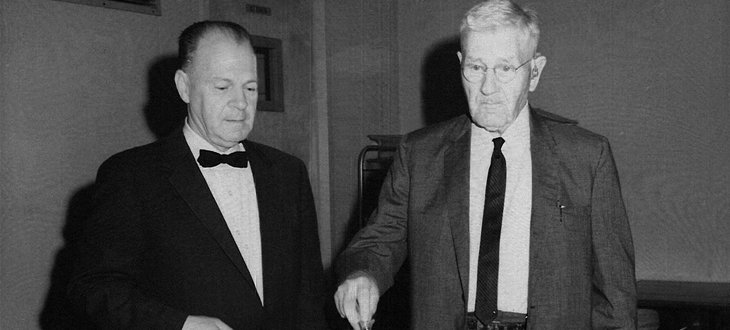
Century-Old Contractors Power America’s Past and Future
Some of the nation’s oldest electrical contracting companies have discovered the secrets to staying in business and evolving to satisfy their customers’ changing needs.
Amy Florence Fischbach | Apr 20, 2018
One-hundred years ago, less than 35% of U.S. homes were powered by electricity. During this golden age of opportunity, trail-blazing electricians founded their own electrical contracting companies in American cities nationwide. Oftentimes, these entrepreneurs opened their doors with little more than a dream, a storefront, and a passion for electrification. Some of these business ventures eventually disappeared from the industry, but others stood the test of time — and are still standing today.
Succeeding in the electrical construction market for a century or more requires lots of determination — and a little bit of luck, says Fred Sargent, who retired from Sargent Electric after many years of leading the company.
“Once a company is within striking distance of reaching its 100-year mark, its owners and managers begin to eye that as a goal for the company and a legacy of their tenure,” Sargent says. “A contracting business equals the contracts it has in effect. Finding new business opportunities that will sustain its operation is a fundamental requirement.”
Following are the stories of how Sargent Electric and nine other electrical contracting companies got their start. Although they may differ in size, market specializations, and geographical location, they have one thing in common — they have all managed to stay in business for a century or more in today’s competitive electrical industry.
Note: This article is not a ranking of companies, nor is it an all-inclusive list of every electrical contracting company in the country founded more than 100 years ago. It is merely a historical look back at SOME of the oldest contractors in the nation that showcases the electrical contracting profession’s rich history and tradition. The 10 featured companies are presented in alphabetical order.
100+ Years of Service: Hawkins Electric Service, Inc.
Hawkins Electric Service, Inc.
Laurel, Md.
Founded 1918
Jay C “Pop” Hawkins, founder of Hawkins Electric Service, Inc., developed a knack for tinkering with electrical systems in the early days of electrification. In 1918, he pedaled his bike through the neighborhood to perform electric repairs for his neighbors. Over the decades that would follow, Pop Hawkins steadily grew a successful business.
After operating the business out of his home in Riverdale, Md., Hawkins opened a store in Hyattsville, Md. in 1942 to sell and repair appliances. In addition, the store sold Lionel model train sets, which attracted a future leader — Nevin Shatzer, a teenage model train collector — to work for the company.
A 1929 Hawkins Electric service truck is decked out for a Fourth of July parade in Hyattsville, Md.
In the late 1950s, Shatzer cleaned the Hawkins Electric store in exchange for Lionel train cars. Eventually, he was promoted from stock boy to an apprentice electrician in his after-school hours. Over the next few decades, Shatzer helped wire thousands of homes in the region, and in 1972, he and two partners purchased the company. Shatzer also passed the love of the electrical trade and his business down to his two sons, Eric and Todd.
Back when he was only eight years old, Eric remembers visiting a job site with his father and learning how to install switches and plugs. Today, he is a master electrician, the president, and CEO of Hawkins Electric Service, Inc., and has two sons who are learning the family business.
Jay C. “Pop” Hawkins (right), who founded Hawkins Electric in 1918, marks the company’s 50th anniversary.
“My father started working at the company when he was 14, and he loved the company so much it was the only place he ever worked,” Eric Shatzer says. “He eventually bought the business and carried on the company’s business model of doing the right thing. My father instilled those values in my brother and me when we were teenagers working at Hawkins.”
Since 1972, Hawkins Electric Service, Inc., has been owned by the Shatzer family, but it still bears the Hawkins name — a tribute to the original founder.
“We thought about changing the name over the years, but it was such a well-known name, that we thought, ‘Let’s leave a good thing alone,’” says Todd Shatzer, current executive vice president of Hawkins Electric, which specializes in commercial and multi-family projects.
Over the last decade, the company has doubled its revenue, tripled its facility space, and tripled its number of employees. The contractor, which is celebrating its centennial in Laurel, Md., this year, also has invested in new technology and training for its 90-plus employees and focused on building relationships with industry partners.
“We are confident that this business model will carry us through the next 100 years,” says Eric Shatzer.
Seven Secrets to Staying in Business for 100 Years or More
Some of the nation’s oldest electrical contracting companies have been able to stay in business for at least a century by adapting to changes in the industry and embracing new markets. Here are some of their strategies for not only surviving for 100 years, but also for planning for future growth and expansion.
- Adapt to customers’ changing needs. By keeping its customers at the forefront of its business plans, Sargent Electric can prepare its teams for the projects and technologies of the future. “Most of the emerging trends in our industry favor contractors that are providing full-service solutions for their customers, able to go wherever the customer needs them, and with the flexibility to work in a variety of team structures and contracting models,” says Rob Smith, president of the company.
- Train your workforce. Cache Valley Electric fosters a company culture that builds loyalty, camaraderie, and common purpose, treats each employee as irreplaceable, and invests in advanced training. “This training doesn’t just grow their value within our industry — it also builds their own sense of self-worth and accomplishment,” says Nate Wickizer, CEO of the company.
- Invest in technology. Hawkins Electric Service has strived to stay on the leading edge of technology through use of 3D modeling and GPR robotics on new construction projects. In addition, the field workforce uses iPads loaded with project management software and advanced equipment to troubleshoot underground faults.
- Treat your customers with respect, honesty, and fairness, according to the third-generation leaders of Hawkins Electric Service, who were always taught to “do the right thing.”
- Serve your community. At Hawkins Electric, the company’s executives and employees have made a strong commitment to the community through monetary, material and labor donations. In addition, the company executives are active in leadership roles in industry associations and encourage their employees to do the same.
- Secure repeat contracts. As Hawkins looks to solidify its regional presence and expand geographically, the contractor is focusing on building trusting and nurturing relationships with its industry partners.
- Network with other contractors. For the last 35 years, H.B. Frazer has served as a member of the Federated Electrical Contractors, which includes 37 other contractors, including Guarantee Electrical, OESCO, and Cache Valley Electric. These companies work together on joint ventures for clients both in the United States and abroad. “Being a Federated contractor is a great opportunity to meet and grow our business and learn from one another,” says Bill Holleran, president of H.B. Frazer.
Notable Changes Over the Last 100 Years
Rob Smith, president of Sargent Electric, shares three ways his company and the electrical industry has changed since his business first opened its doors.
- More reliable and safer solutions at a lower cost.
- Improved electrical safety for the end-user and owner/ operator of the facilities and for the electricians who make it all happen.
- Innovations through all aspects of the supply chain, which reduces labor hours and costs. Also, the shift from building in the field to assembling advanced components and preassemblies boosts productivity.
Early Years of Electrification: A Timeline
1752: Ben Franklin ties a kite to a string during a thunderstorm.
1800: The first electric battery was founded by Alessandro Volta.
1821: Michael Faraday first discovered electro-magnetic rotation.
1826: Georg Ohm created Ohm’s Law.
1837: Thomas Davenport invented the first electric motor.
1878: Joseph Swan invented the first incandescent light bulb, which burned out quickly, and Thomas Edison founded the Edison Electric Light Co.
1879: Thomas Edison invented the first long-lasting incandescent light bulb, which could be used for at least 40 hours without burning out.
1882: Thomas Edison opened a power station, which could power 5,000 lights.
1883: Nikola Tesla invented the Tesla coil.
1893: The Westinghouse Electric Co. used AC current to light the Chicago’s World’s Fair.
1936: The Rural Electrification Act was aimed at providing electricity to farms in America.
1942: About half of the American farms had electricity.
Source: U.S. Energy Information Administration
To read the full article, click here:
http://www.ecmweb.com/construction/century-old-contractors-power-america-s-past-and-future
Back to all articles






